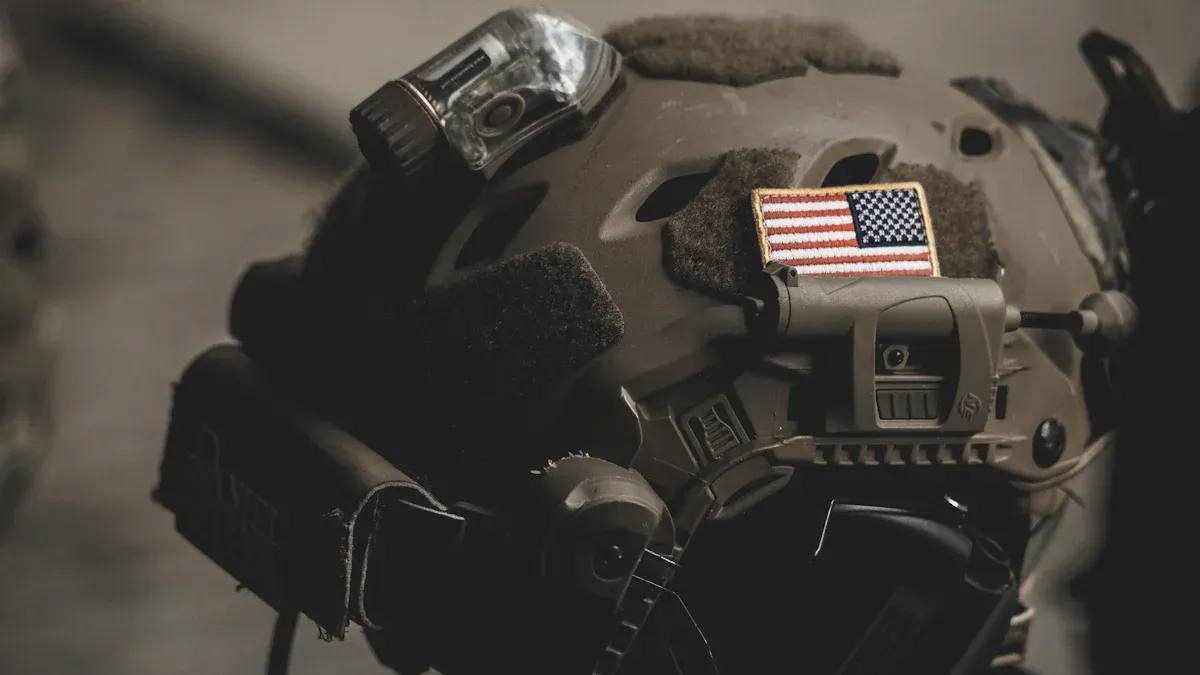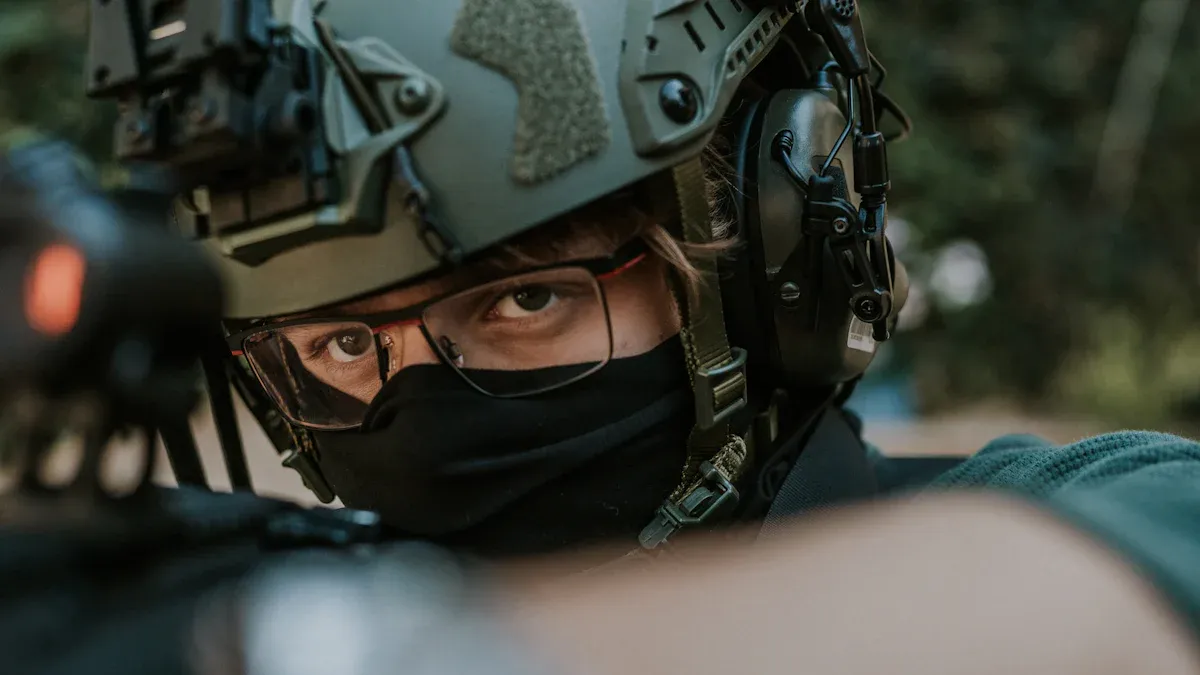
You need to know how a fast helmet protects you in dangerous situations. Ballistic protection levels show the strength of your helmet against different threats.
Testing uses strict standards so you can trust your gear in the field.
What Is FAST Helmet?

FAST Helmet Design
The design of the fast helmet focuses on modern combat needs. You notice the shell has a high-cut shape. This shape lets you use communication headsets and other gear without trouble.
The helmet uses lightweight materials like advanced polymers and composites. These materials keep the helmet strong but easy for you to wear for long periods.
You find rails and mounting points on the sides and front of the helmet. These features allow you to attach night vision devices, cameras, and lights.
The helmet also has padding inside. This padding improves comfort and helps absorb impact. The chin strap system keeps the helmet secure on your head, even during fast movements.
Protective Features
Fast helmets offer ballistic protection against handgun rounds and shrapnel. The shell resists penetration from common threats you might face in tactical situations. You get extra coverage around the sides and back of your head.
The helmet also helps reduce blunt force injuries from falls or impacts.
.jpg)
You can upgrade the helmet with additional armor plates or face shields. These upgrades give you more protection if your mission requires it.
The helmet’s design lets you stay alert and move freely while staying safe.
You should choose a helmet that matches your operational needs.
Look for features that support your gear and provide the right level of protection.
Ballistic Protection Levels of FAST Army Helmet
NIJ and Other Standards
You need to know how ballistic helmets get rated for protection. The National Institute of Justice sets the main ballistic standards for helmet safety.
You see these standards called NIJ standards or the NIJ standard. They help you compare different types of ballistic helmets and bulletproof helmets. The NIJ levels range from IIA to IV. Each level shows the resistance of the helmet against specific threats.
You find most fast helmet models tested to NIJ Level IIIA. This level means your helmet can stop most handgun rounds, including .44 Magnum and 9mm.
You do not get rifle protection at this level. Some advanced ballistic helmets reach higher levels, but you must check the manufacturer’s certification.
Shell thickness plays a big role in ballistic resistance. You see most fast helmet shells measure between 7mm and 12mm thick.
Thicker shells give you more protection but add weight. Manufacturers use advanced materials to balance protection and comfort. You need to look for helmets that meet ballistic standards and fit your mission needs.
Protection Against Pistol and Rifle Rounds
You want your helmet to protect you from real threats. Ballistic helmets like the fast helmet focus on stopping pistol rounds and shrapnel.
You get strong protection against common handgun calibers. Most fast helmet models do not stop rifle rounds. Only a few types of ballistic helmets offer limited rifle resistance, and these often feel heavier.
You should understand the limits of your helmet’s ballistic protection. NIJ Level IIIA helmets protect you from most handgun threats.
You do not get full rifle protection unless you use special add-ons or choose heavier bulletproof helmets. The shell design and material affect the helmet’s resistance to penetration and blunt force.
You see some helmets tested against extra threats, like fragmentation or shotgun pellets. These tests follow ballistic standards set by the NIJ and other agencies.
You need to match your helmet’s protection level to your operational risks. If you expect rifle fire, you must consider additional armor or different types of ballistic helmets.
You get the best safety when you choose a helmet that meets the right ballistic standards and fits your needs. You should never assume all helmets offer the same resistance. You need to check the NIJ standard, shell thickness, and protection rating before you decide.
FAST Army Helmet Testing

Ballistic Testing Methods
You want to trust your helmet in real-world situations. Manufacturers use extensive testing to make sure ballistic helmets meet strict safety standards.
You see in-house ballistic testing as a key step in the process. Technicians place the helmet on a special headform. They fire different types of ammunition at specific points on the shell. This method checks the helmet’s resistance to penetration and its ability to stop bullets.
You find that ballistic testing covers a range of threats.
Testers use handgun rounds like 9mm, .357 Magnum, and .44 Magnum. Some tests include fragments from explosions or shotgun pellets. Each test follows a set protocol. You get clear data on how the helmet performs under direct fire. The results show if the helmet meets the required ballistic protection level.
Environmental and Impact Tests
You need your helmet to perform in every condition. Environmental testing exposes ballistic helmets to heat, cold, moisture, and sunlight.
These tests make sure the helmet’s materials, like kevlar and advanced composites, keep their strength. You do not want your helmet to fail in extreme weather.
Impact testing checks how well the helmet absorbs shocks. Testers drop weights on the helmet from different heights.
They measure how much force reaches the inside. You want low force transfer to protect your skull and brain. Ballistic helmets must show strong impact resistance as well as ballistic protection.
You see bulletproof helmets go through chemical exposure tests. These tests check if oils, fuels, or cleaning agents weaken the shell. You also find vibration and drop tests. These simulate real-life bumps and falls. The helmet must keep its shape and performance after every challenge.
You get the best protection when you choose a helmet that passes all these tests. Manufacturers use extensive testing to guarantee your safety. You should look for helmets with clear certification and proven resistance to real threats.
Interpreting Ballistic Helmet Results
Real-World Protection
You want to know how ballistic test results affect your safety in real life. When you see a helmet pass strict ballistic testing, you can trust it to give you strong protection against real threats.
Ballistic helmets stop bullets and fragments that could cause serious injury. You get head protection from handgun rounds, shrapnel, and blunt force. The fast helmet uses advanced materials like kevlar to boost its performance.
You can move with confidence because the helmet absorbs impact and reduces the risk of trauma.
You should remember that no helmet can stop every threat. Ballistic protection levels show you what the helmet can handle. If you face rifle fire, you need to check if your helmet meets that higher standard. Always match your helmet’s protection to your mission.
Real-world protection depends on the right fit, proper use, and understanding the limits of your gear.
Certification and Compliance
You need to check for certification before you trust any helmet. Certified ballistic helmets meet official standards for ballistic protection and impact resistance.
Look for labels or documents that show the helmet passed NIJ or other trusted tests. Certification proves the helmet went through real testing and met strict rules.
You should also check for compliance with military or law enforcement standards. Some helmets meet extra rules for fast deployment or special missions.
A helmet with proper certification gives you peace of mind. You know it offers the protection you need in the field.
Choosing FAST Helmet Protection
Matching Protection to Needs
You need to match your helmet’s protection level to your mission. Start by thinking about the threats you might face.
If you expect handgun fire or shrapnel, a lightweight helmet with NIJ Level IIIA protection works well. This type of helmet gives you comfort and mobility for long tactical operations.
When you need extra coverage, look for tactical helmets with options for side or face shields.
Limitations and Considerations
No helmet gives you total protection. You must know the limits of your gear. Most helmets stop handgun rounds, but not rifle bullets.
If you need rifle protection, you may need to add extra armor or choose a heavier helmet. Lightweight helmet designs offer comfort, but sometimes less coverage.
Environmental factors matter. Heat, cold, and moisture can affect your helmet’s performance. Always check for damage after impacts.
Even small cracks can lower your protection. Remember, tactical helmets are only one part of your safety plan. Combine them with other protective equipment for full coverage.
Conclusion
You now understand how experts test FAST helmets for ballistic protection. Testing follows strict standards to ensure your safety. Always check for certifications before you choose your helmet.
Remember: The right helmet protects you only if it matches your mission needs.
- Review test results
- Match protection levels to your risks
- Trust certified products
Choose wisely to stay safe in every situation.
